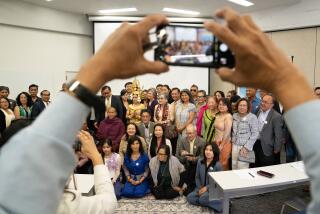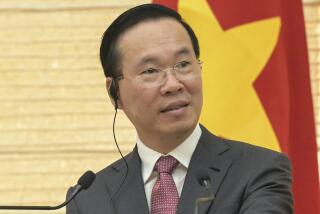Vietnam Starts Its Cambodia Troop Pullout
BANGKOK, Thailand — The Vietnamese army Thursday began a weeklong, partial withdrawal from Cambodia, expressing confidence that its remaining troops and its Cambodian allies can hold off any advance by Khmer Rouge guerrillas.
Lt. Gen. Nguyen Van Thai, an army spokesman, told reporters in Ho Chi Minh City earlier this week that the withdrawal of 18,000 troops this week and next will fulfill Hanoi’s pledge to pull out 50,000 troops this year. Thai added that 50,000 Vietnamese soldiers will remain.
Western diplomats in Bangkok disagreed with Hanoi’s figures, but one of them said: “We welcome what is in fact a reduction of troops. It’s a move in the right direction.” By Western estimates, the current withdrawal will leave approximately 100,000 Vietnamese soldiers in Cambodia.
The continuing pullout of the Vietnamese army, which invaded Cambodia in December, 1978, and installed a client regime in Phnom Penh, underlines a halting movement toward a diplomatic settlement of the Cambodian issue.
Plagued by a stagnant domestic economy and under pressure from the Soviet Union, its principal international patron, Hanoi has vowed to withdraw all of its troops by the end of 1990--or by as early as the spring of 1989 if a political settlement is reached by then with guerrillas of the Cambodian resistance.
“The emphasis, everybody now feels, is on the diplomatic and political effort,” another Bangkok-based diplomat said.
In one of a series of contacts among the factions, former Cambodian head of state Norodom Sihanouk, the acknowledged leader of the resistance, met Tuesday outside Paris with Khieu Samphan, a top official of the Khmer Rouge. The Communist Khmer Rouge had exercised a tyrannical reign over the country until it was driven from Phnom Penh by the invading Vietnamese in 1978.
The role of the Khmer Rouge remains a principal sticking point in settlement talks, particularly as they center on the military situation. With 30,000 to 40,000 battle-hardened guerrillas armed with Chinese-supplied weapons, the Communist faction is the strongest in the resistance and poses an increasing threat to the Phnom Penh government as the Vietnamese withdraw.
Capable Force
But Vietnamese Gen. Thai insisted that the Phnom Penh army, with the support of Hanoi’s remaining troops, “can take care of themselves.” An attempt by the Khmer Rouge last month to mass guerrillas and civilians along the Thai-Cambodian border was foiled by heavy artillery bombardments, according to diplomats here.
However, one envoy pointed out, when the Vietnamese earlier this year pulled their front-line units back from the Thai border about 18 miles, the Phnom Penh regulars, assigned to block infiltration by resistance guerrillas, “got their butts kicked, by and large, and the Vietnamese were called back in again and again.”
More troubling, many of the clashes in the border area pitted one guerrilla faction against another, primarily the Khmer Rouge and Sihanouk’s army, which has an estimated 16,000 guerrilla troops. The third faction, the Khmer People’s National Liberation Front, has about 11,000 troops, according to latest Western estimates.
Opposing the resistance guerrillas are the remaining Vietnamese and a Phnom Penh army of 44,000 regulars and 50,000 provincial and local militiamen.
The political challenge is to devise a formula to disengage and control the Cambodian factions and meet two agreed objectives: a complete Vietnamese pullout and what diplomats call the “non-return” of the Khmer Rouge to power in Phnom Penh. While all sides have called for an eventual neutral government in Cambodia, Hanoi, despite its troubles, is expected to give up its influence in the country only grudgingly.
Stagnation of the settlement process, however, could yield to improving relations between the Soviet Union and China, sponsors of the two main contenders. The Cambodian issue held a high priority at recent talks in Moscow between the foreign ministers of the Kremlin and Beijing and is expected to be discussed again when the ministers meet early next year in Beijing.
The current Vietnamese withdrawal will take place along four land routes and down the Mekong River, Gen. Thai said. Six thousand Vietnamese troops and 300 vehicles, he disclosed, were beginning a five-day overland pullback from the Battambang and Sisophon areas in western Cambodian to the Vietnamese province of Tay Ninh. An infantry division and an engineering regiment based in the Phnom Penh area will be taken by ship down the Mekong to southern Vietnam.
More to Read
Sign up for Essential California
The most important California stories and recommendations in your inbox every morning.
You may occasionally receive promotional content from the Los Angeles Times.










